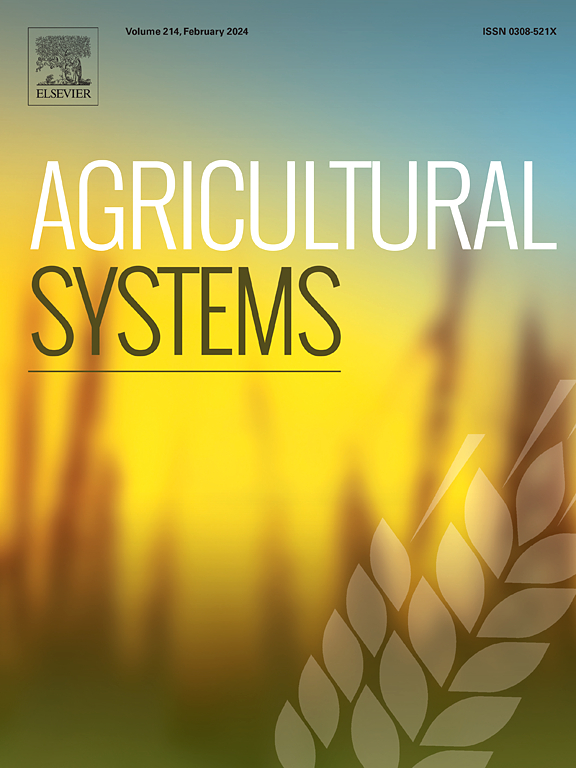Probabilistic estimates of drought-induced yield loss in the Southeastern United States
IF 6.1
1区 农林科学
Q1 AGRICULTURE, MULTIDISCIPLINARY
引用次数: 0
Abstract
Context
Drought is an insidious climate hazard. It has devastating impacts on rainfed agriculture: loss in yield threatens food security, affects farmers, and have serious socio-economic ramifications. Their multifaceted impacts on agriculture, crop yield, food production, and the economy are often irreversible. The frequency and severity of drought events are increasing as the climate changes. Therefore, a better understanding of their effects is needed to mitigate their impacts on water and food security.
Objective
Here, a probabilistic approach is employed to assess the potential threat that drought poses to four major cash crops in the Southeastern United States: corn, cotton, peanuts, and soybeans.
Methods
Copula is used to model the dependence, at the county level, between the Standardized Precipitation and Evapotranspiration Index (SPEI) and crop yield. Drought-induced yield loss, for each county, is quantified and the joint probability as well as the conditional probability of yield loss given an impending drought is calculated to identify counties that are most vulnerable.
Results and conclusions
Drought characteristics significantly affect yield: corn was the most vulnerable, whereas the loss incurred by the other crops were less severe. Further, counties in South Georgia suffered relatively lower losses, which may be attributed to the adoption of irrigation practices following the 2005/06 drought.
Significance
This study demonstrates the detrimental effect of drought on rainfed agriculture, underscoring the need for comprehensive drought management strategies. The methodology employed in this study can be incorporated into a dashboard or decision support system that farmers, planners, and economists can use to make informed decisions based on the potential risks that drought poses to their counties and state, and thus develop adequate mitigation plans, including the estimation of insurance and compensation.

美国东南部干旱导致的产量损失的概率估计
干旱是一种潜在的气候危害。它对雨养农业产生毁灭性影响:产量损失威胁粮食安全,影响农民,并产生严重的社会经济后果。它们对农业、作物产量、粮食生产和经济的多方面影响往往是不可逆转的。随着气候的变化,干旱事件的频率和严重程度都在增加。因此,需要更好地了解它们的影响,以减轻它们对水和粮食安全的影响。目的:本文采用概率方法评估干旱对美国东南部四种主要经济作物(玉米、棉花、花生和大豆)的潜在威胁。方法利用scopula模拟了标准化降水和蒸散指数(SPEI)与县域作物产量的关系。对每个县的干旱导致的产量损失进行了量化,并计算了在即将发生干旱的情况下产量损失的联合概率和条件概率,以确定最脆弱的县。结果与结论干旱特征对产量影响显著,玉米最脆弱,其他作物损失较轻。此外,南乔治亚县遭受的损失相对较小,这可能是由于在2005/06年干旱后采取了灌溉措施。本研究揭示了干旱对雨养农业的不利影响,强调了制定综合干旱管理策略的必要性。本研究中采用的方法可以整合到仪表板或决策支持系统中,农民、规划师和经济学家可以使用该系统根据干旱对其县和州构成的潜在风险做出明智的决策,从而制定适当的缓解计划,包括估计保险和赔偿。
本文章由计算机程序翻译,如有差异,请以英文原文为准。
求助全文
约1分钟内获得全文
求助全文
来源期刊

Agricultural Systems
农林科学-农业综合
CiteScore
13.30
自引率
7.60%
发文量
174
审稿时长
30 days
期刊介绍:
Agricultural Systems is an international journal that deals with interactions - among the components of agricultural systems, among hierarchical levels of agricultural systems, between agricultural and other land use systems, and between agricultural systems and their natural, social and economic environments.
The scope includes the development and application of systems analysis methodologies in the following areas:
Systems approaches in the sustainable intensification of agriculture; pathways for sustainable intensification; crop-livestock integration; farm-level resource allocation; quantification of benefits and trade-offs at farm to landscape levels; integrative, participatory and dynamic modelling approaches for qualitative and quantitative assessments of agricultural systems and decision making;
The interactions between agricultural and non-agricultural landscapes; the multiple services of agricultural systems; food security and the environment;
Global change and adaptation science; transformational adaptations as driven by changes in climate, policy, values and attitudes influencing the design of farming systems;
Development and application of farming systems design tools and methods for impact, scenario and case study analysis; managing the complexities of dynamic agricultural systems; innovation systems and multi stakeholder arrangements that support or promote change and (or) inform policy decisions.
 求助内容:
求助内容: 应助结果提醒方式:
应助结果提醒方式:


